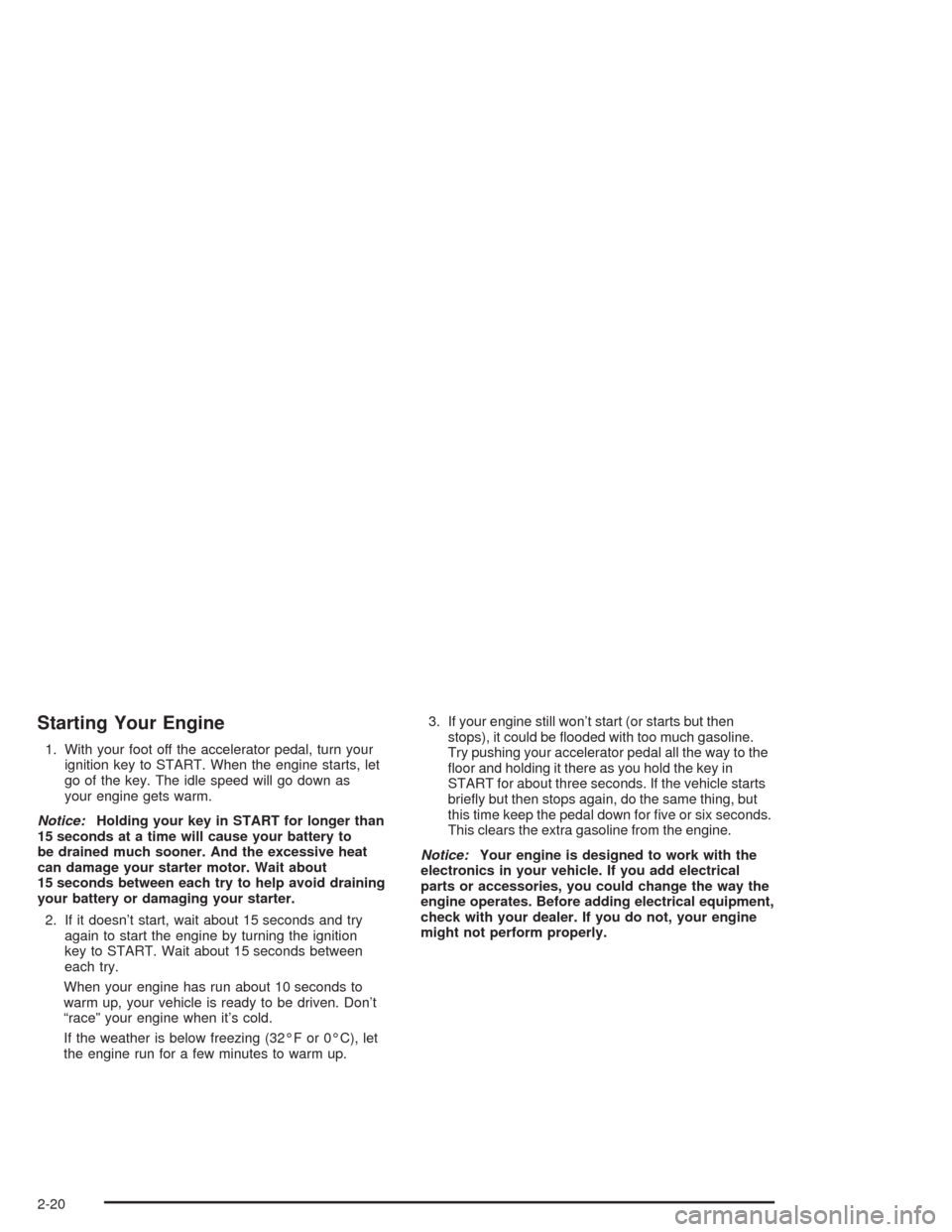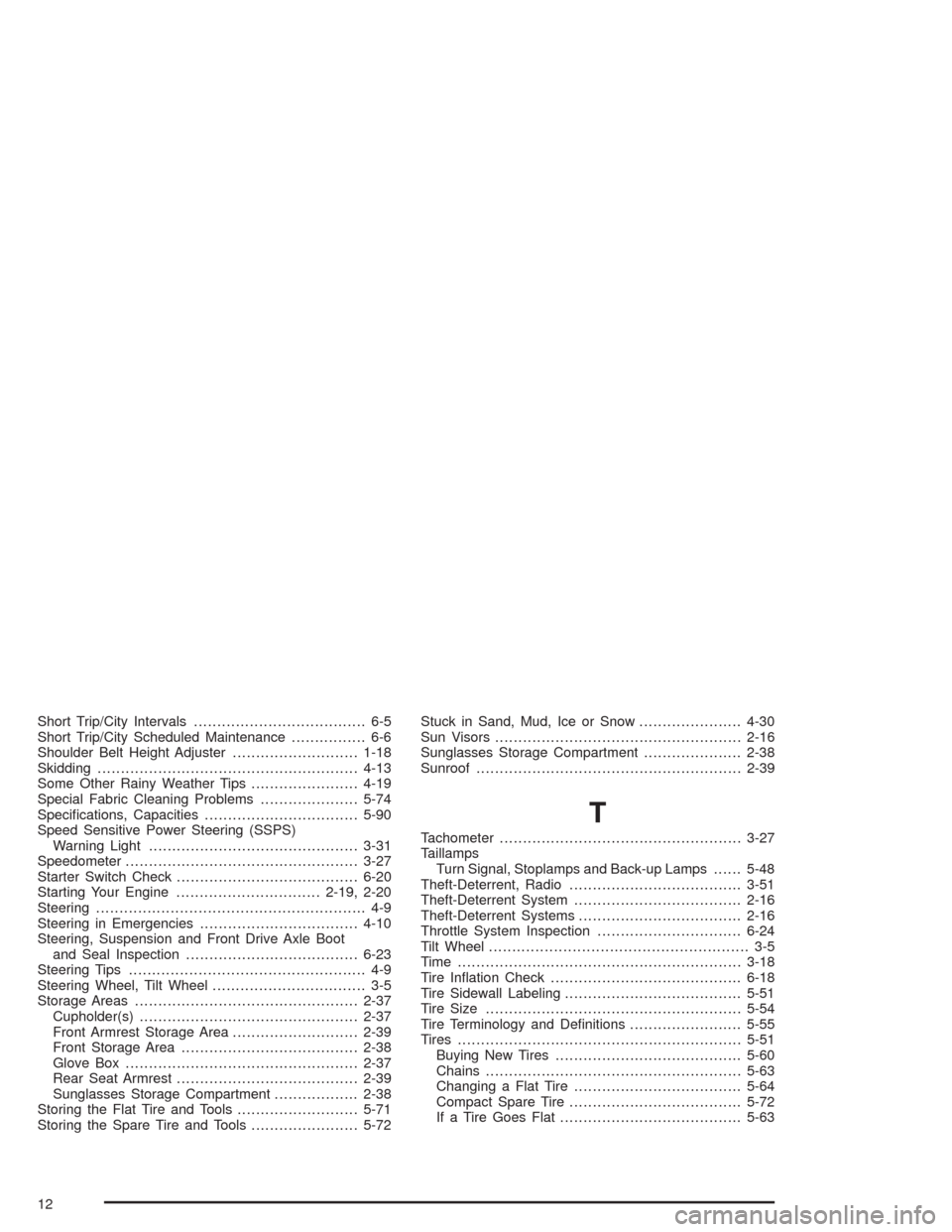starter CHEVROLET OPTRA 2004 1.G Owners Manual
[x] Cancel search | Manufacturer: CHEVROLET, Model Year: 2004, Model line: OPTRA, Model: CHEVROLET OPTRA 2004 1.GPages: 346, PDF Size: 2.38 MB
Page 88 of 346

Starting Your Engine
1. With your foot off the accelerator pedal, turn your
ignition key to START. When the engine starts, let
go of the key. The idle speed will go down as
your engine gets warm.
Notice:Holding your key in START for longer than
15 seconds at a time will cause your battery to
be drained much sooner. And the excessive heat
can damage your starter motor. Wait about
15 seconds between each try to help avoid draining
your battery or damaging your starter.
2. If it doesn’t start, wait about 15 seconds and try
again to start the engine by turning the ignition
key to START. Wait about 15 seconds between
each try.
When your engine has run about 10 seconds to
warm up, your vehicle is ready to be driven. Don’t
“race” your engine when it’s cold.
If the weather is below freezing (32°F or 0°C), let
the engine run for a few minutes to warm up.3. If your engine still won’t start (or starts but then
stops), it could be flooded with too much gasoline.
Try pushing your accelerator pedal all the way to the
floor and holding it there as you hold the key in
START for about three seconds. If the vehicle starts
briefly but then stops again, do the same thing, but
this time keep the pedal down for five or six seconds.
This clears the extra gasoline from the engine.
Notice:Your engine is designed to work with the
electronics in your vehicle. If you add electrical
parts or accessories, you could change the way the
engine operates. Before adding electrical equipment,
check with your dealer. If you do not, your engine
might not perform properly.
2-20
Page 310 of 346

At Least Once a Year
Key Lock Cylinders Service
Lubricate the key lock cylinders with the lubricant
specified in Part D.
Body Lubrication Service
Lubricate all hood latch assemblies, secondary latch,
pivots, spring anchor, release pawl, hood and body door
hinges, rear compartment and any folding seat
hardware. Part D tells you what to use. More frequent
lubrication may be required when exposed to a corrosive
environment.
Starter Switch Check
{CAUTION:
When you are doing this inspection, the
vehicle could move suddenly. If the vehicle
moves, you or others could be injured.1. Before you start, be sure you have enough room
around the vehicle.
2. Firmly apply both the parking brake and the regular
brake. SeeParking Brake on page 2-28if
necessary.
Do not use the accelerator pedal, and be ready to
turn off the engine immediately if it starts.
3. On automatic transaxle vehicles, try to start the
engine in each gear. The starter should work only in
PARK (P) or NEUTRAL (N). If the starter works in
any other position, your vehicle needs service.
On manual transaxle vehicles, put the shift lever in
NEUTRAL (N), push the clutch down halfway and try
to start the engine. The starter should work only
when the clutch is pushed down all the way to the
floor. If the starter works when the clutch is not
pushed all the way down, your vehicle needs service.
6-20
Page 344 of 346

Short Trip/City Intervals..................................... 6-5
Short Trip/City Scheduled Maintenance................ 6-6
Shoulder Belt Height Adjuster...........................1-18
Skidding........................................................4-13
Some Other Rainy Weather Tips.......................4-19
Special Fabric Cleaning Problems.....................5-74
Specifications, Capacities.................................5-90
Speed Sensitive Power Steering (SSPS)
Warning Light.............................................3-31
Speedometer..................................................3-27
Starter Switch Check.......................................6-20
Starting Your Engine...............................2-19, 2-20
Steering.......................................................... 4-9
Steering in Emergencies..................................4-10
Steering, Suspension and Front Drive Axle Boot
and Seal Inspection.....................................6-23
Steering Tips................................................... 4-9
Steering Wheel, Tilt Wheel................................. 3-5
Storage Areas................................................2-37
Cupholder(s)...............................................2-37
Front Armrest Storage Area...........................2-39
Front Storage Area......................................2-38
Glove Box..................................................2-37
Rear Seat Armrest.......................................2-39
Sunglasses Storage Compartment..................2-38
Storing the Flat Tire and Tools..........................5-71
Storing the Spare Tire and Tools.......................5-72Stuck in Sand, Mud, Ice or Snow......................4-30
Sun Visors.....................................................2-16
Sunglasses Storage Compartment.....................2-38
Sunroof.........................................................2-39
T
Tachometer....................................................3-27
Taillamps
Turn Signal, Stoplamps and Back-up Lamps......5-48
Theft-Deterrent, Radio.....................................3-51
Theft-Deterrent System....................................2-16
Theft-Deterrent Systems...................................2-16
Throttle System Inspection...............................6-24
Tilt Wheel........................................................ 3-5
Time .............................................................3-18
Tire Inflation Check.........................................6-18
Tire Sidewall Labeling......................................5-51
Tire Size.......................................................5-54
Tire Terminology and Definitions........................5-55
Tires.............................................................5-51
Buying New Tires........................................5-60
Chains.......................................................5-63
Changing a Flat Tire....................................5-64
Compact Spare Tire.....................................5-72
If a Tire Goes Flat.......................................5-63
12